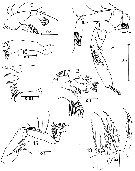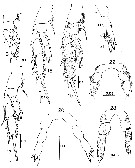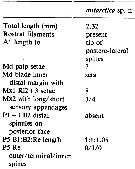|
|
 |
Fiche d'espèce de Copépode |
|
|
Calanoida ( Ordre ) |
|
|
|
Clausocalanoidea ( Superfamille ) |
|
|
|
Scolecitrichidae ( Famille ) |
|
|
|
Cenognatha ( Genre ) |
|
|
| |
Cenognatha antarctica (Hulsemann, 1985) (F, Juv.M) | |
| | | | | | | Syn.: | Neoscolecithrix antarctica Hulsemann, 1985 (p.55, Descr., figs. C5, F & M); Razouls & al., 2000 (p.343, tab. 2, Appendix); Boxshall & Halsey, 2004 (p.191, fig.F) | | | | Ref.: | | | Bradford-Grieve, 2001 a (p.792, Rem.); Bradford-Grieve, 2004 (p.285) |  issued from : K. Hulsemann in Polar Biol., 1985,5. [p.57, Figs.1-7]. As Neoscolecithrix antarctica. Female (from W Weddell Sea): 1-2, habitus (dorsal and lateral, respectively); 2-4, urosome (dorsal and lateral, respectively); 5, genital segment (ventral); 6, anal segment and caudal rami (ventral); 7, forehead (ventral). Scales in mm. Nota: Head and 1st pedigerous segment fused, 4th and 5th separate. The posterolateral margin of the last segment carries 2 posteriad directed points separated by a wide gap. Simple rostrum with 2 prongs drawn out into filaments. Ratio of lengths Prosome/Urosome = 3.30. Urosome 4-segmented; a row of short hairs accompanies the posterior margins of urosomal segments 1-3; in addition, there are ventro-lateral patches of hair and lateral patches of spinules on the genital segment. Anal segment short. Length of caudal ramus nearly twice its width. A1 24-segmented
|
 issued from : K. Hulsemann in Polar Biol., 1985,5. [p.58, Figs.8-15]. As Neoscolecithrix antarctica. Female: 8, A2; 9, Md (mandibular palp); 10, Md (mandibular blade); 11, Md (cutting edge); 12, Mx1; 13, Mx2; 14, Mx2 (5th lobe); 15, Mxp. Scales in mm. Nota: Posterior side of the 1st basipodal segment of A2 with a patch of hair-like setae; the inner lobe of the 2nd segment of the endopod with 8 setae, the outer lobe 7 setae. The 1st inner lobe of Mx1 is armed with 9 strong and 4 slender spines. 3 setae on the 2nd inner lobe; 4 on the 3rd inner lobe; 5 on the 2nd basal segment; 3, 3, 5 on endopodal segments 1-3; 9 each on the exopod and the outer lobe, respectively. Lobe 1 of Mx2 with 5 setae, and lobes 2-4 each with 1 short and 2 long setae; lobe 5 carries a strong spine in addition to 3 setae of which the 2 shorter ones appear to be modified to sensory filaments; from the endopodal segments originate 2 types of sensory appendages: there appear to be 4 with a small apical \"brush\" and 3 which are larger and undifferenciated. Of the 6 setae on 1st basipodal segment of Mxp, 2 are modified to filamentous sensory structures; endopodal segments 1-5 armed with 4, 4, 3, 3+1 and 3.1 setae, respectively.
|
 issued from : K. Hulsemann in Polar Biol., 1985,5. [p.59, Figs.16-21]. As Neoscolecithrix antarctica. Female: 16-18, P1 to P3; 19, left P4 (posterior face); 20, P5 (anterior face); 21, right P5 (posterior face). Copepodid female stage V: 22, P5 (posterior face. Copepodid Male stage V: P5 (posterior face. Scales in mm.
|
 issued from : K. Hulsemann in Polar Biol., 1985,5. [p.61, Table 2]. As Neoscolecithrix antarctica. Selected characters in females. B = basipod; Ri = endopod; Re = exopod.
| | | | | Ref. compl.: | | | Hopkins (1985) | | | | NZ: | 1 | | |
|
Carte de distribution de Cenognatha antarctica par zones géographiques
|
| | | | | | | Loc: | | | Antarctic: Peninsula (SW Atlant.: Antarctic Sound, Croker Passage) | | | | N: | 2 | | | | Lg.: | | | (584) F: 2,32; juv.5 M: 1,82-1,66; {F: 2,32} | | | | Rem.: | épi-bathypélagique.
Pour Vyshkvartzeva (2000, p.217) cette espèce appartiendrait aux Scolecitrichidae.
Voir aussi les remarques en anglais | | | Dernière mise à jour : 31/12/2014 | |
|
|
 Toute utilisation de ce site pour une publication sera mentionnée avec la référence suivante : Toute utilisation de ce site pour une publication sera mentionnée avec la référence suivante :
Razouls C., Desreumaux N., Kouwenberg J. et de Bovée F., 2005-2025. - Biodiversité des Copépodes planctoniques marins (morphologie, répartition géographique et données biologiques). Sorbonne Université, CNRS. Disponible sur http://copepodes.obs-banyuls.fr [Accédé le 05 janvier 2026] © copyright 2005-2025 Sorbonne Université, CNRS
|
|
 |
 |







